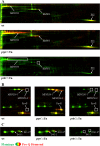The phosphoproteome of the minimal bacterium Mycoplasma pneumoniae: analysis of the complete known Ser/Thr kinome suggests the existence of novel kinases
- PMID: 20097688
- PMCID: PMC2877983
- DOI: 10.1074/mcp.M900267-MCP200
The phosphoproteome of the minimal bacterium Mycoplasma pneumoniae: analysis of the complete known Ser/Thr kinome suggests the existence of novel kinases
Abstract
Mycoplasma pneumoniae belongs to the Mollicutes, the group of organisms with the smallest genomes that are capable of host-independent life. These bacteria show little regulation in gene expression, suggesting an important role for the control of protein activities. We have studied protein phosphorylation in M. pneumoniae to identify phosphorylated proteins. Two-dimensional gel electrophoresis and mass spectrometry allowed the detection of 63 phosphorylated proteins, many of them enzymes of central carbon metabolism and proteins related to host cell adhesion. We identified 16 phosphorylation sites, among them 8 serine and 8 threonine residues, respectively. A phosphoproteome analysis with mutants affected in the two annotated protein kinase genes or in the single known protein phosphatase gene suggested that only one protein (HPr) is phosphorylated by the HPr kinase, HPrK, whereas four adhesion-related or surface proteins were targets of the protein kinase C, PrkC. A comparison with the phosphoproteomes of other bacteria revealed that protein phosphorylation is evolutionarily only poorly conserved. Only one single protein with an identified phosphorylation site, a phosphosugar mutase (ManB in M. pneumoniae), is phosphorylated on a conserved serine residue in all studied organisms from archaea and bacteria to man. We demonstrate that this protein undergoes autophosphorylation. This explains the strong conservation of this phosphorylation event. For most other proteins, even if they are phosphorylated in different species, the actual phosphorylation sites are different. This suggests that protein phosphorylation is a form of adaptation of the bacteria to the specific needs of their particular ecological niche.
Figures






Similar articles
-
Mass spectrometry and site-directed mutagenesis identify several autophosphorylated residues required for the activity of PrkC, a Ser/Thr kinase from Bacillus subtilis.J Mol Biol. 2003 Jul 11;330(3):459-72. doi: 10.1016/s0022-2836(03)00579-5. J Mol Biol. 2003. PMID: 12842463
-
In-Depth Characterization of the Clostridioides difficile Phosphoproteome to Identify Ser/Thr Kinase Substrates.Mol Cell Proteomics. 2022 Nov;21(11):100428. doi: 10.1016/j.mcpro.2022.100428. Epub 2022 Oct 14. Mol Cell Proteomics. 2022. PMID: 36252736 Free PMC article.
-
A novel mode of control of Mycoplasma pneumoniae HPr kinase/phosphatase activity reflects its parasitic lifestyle.Microbiology (Reading). 2002 Oct;148(Pt 10):3277-3284. doi: 10.1099/00221287-148-10-3277. Microbiology (Reading). 2002. PMID: 12368461
-
The bacterial HPr kinase/phosphorylase: a new type of Ser/Thr kinase as antimicrobial target.Biochim Biophys Acta. 2005 Dec 30;1754(1-2):126-31. doi: 10.1016/j.bbapap.2005.07.042. Epub 2005 Sep 8. Biochim Biophys Acta. 2005. PMID: 16202671 Review.
-
HPr kinase/phosphorylase, a Walker motif A-containing bifunctional sensor enzyme controlling catabolite repression in Gram-positive bacteria.Biochim Biophys Acta. 2004 Mar 11;1697(1-2):123-35. doi: 10.1016/j.bbapap.2003.11.018. Biochim Biophys Acta. 2004. PMID: 15023355 Review.
Cited by
-
Evaluation and properties of the budding yeast phosphoproteome.Mol Cell Proteomics. 2012 Jun;11(6):M111.009555. doi: 10.1074/mcp.M111.009555. Epub 2012 Jan 27. Mol Cell Proteomics. 2012. PMID: 22286756 Free PMC article.
-
Eukaryote-like serine/threonine kinases and phosphatases in bacteria.Microbiol Mol Biol Rev. 2011 Mar;75(1):192-212. doi: 10.1128/MMBR.00042-10. Microbiol Mol Biol Rev. 2011. PMID: 21372323 Free PMC article. Review.
-
Network of Surface-Displayed Glycolytic Enzymes in Mycoplasma pneumoniae and Their Interactions with Human Plasminogen.Infect Immun. 2015 Dec 14;84(3):666-76. doi: 10.1128/IAI.01071-15. Infect Immun. 2015. PMID: 26667841 Free PMC article.
-
The Ser/Thr protein kinase PrkC imprints phenotypic memory in Bacillus anthracis spores by phosphorylating the glycolytic enzyme enolase.J Biol Chem. 2019 May 31;294(22):8930-8941. doi: 10.1074/jbc.RA118.005424. Epub 2019 Apr 5. J Biol Chem. 2019. PMID: 30952697 Free PMC article.
-
Interaction of Mycobacterium tuberculosis elongation factor Tu with GTP is regulated by phosphorylation.J Bacteriol. 2011 Oct;193(19):5347-58. doi: 10.1128/JB.05469-11. Epub 2011 Jul 29. J Bacteriol. 2011. PMID: 21803988 Free PMC article.
References
-
- Stülke J., Eilers H., Schmidl S. R. (2009) Mycoplasma and spiroplasma, in Encyclopedia of Microbiology (Schaechter M. ed) pp. 208–219, Elsevier, Oxford
-
- Halbedel S., Hames C., Stülke J. (2007) Regulation of carbon metabolism in the mollicutes and its relation to virulence. J. Mol. Microbiol. Biotechnol 12, 147–154 - PubMed
-
- Atkinson T. P., Balish M. F., Waites K. B. (2008) Epidemiology, clinical manifestations, pathogenesis and laboratory detection of Mycoplasma pneumoniae infections. FEMS Microbiol. Rev 32, 956–973 - PubMed
-
- Jacobs E. (1997) Mycoplasma infections of the human respiratory tract. Wien. Klin. Wochenschr 109, 574–577 - PubMed
Publication types
MeSH terms
Substances
LinkOut - more resources
Full Text Sources
Miscellaneous

